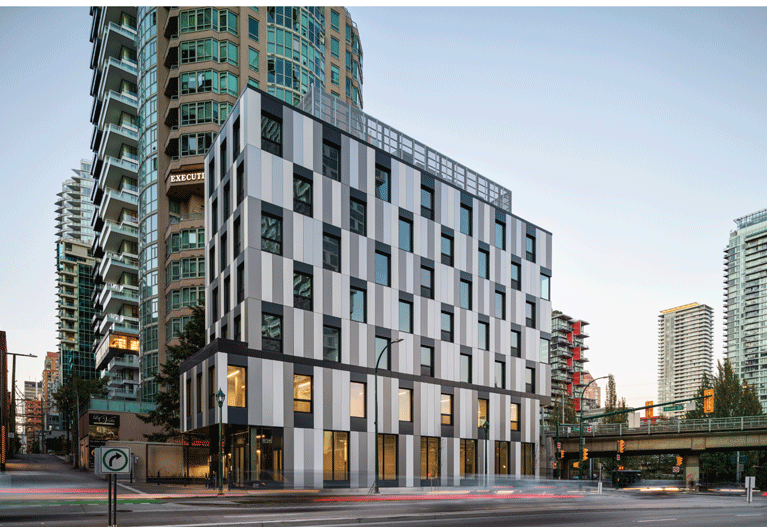
A Catalyst for High-Performance Buildings and Industry Transformation
By Passive House Canada CEO, Chris Ballard Passive House Canada is happy to introduce the annual Passive House issue of SABMag which profiles recently completed Passive House-certified projects from across the country.
We are in overlapping climate, housing, and affordability crises and we must turn to the construction industry to help build and retrofit our way out. But would you turn to an industry that has been notoriously slow to digitize, lagging almost every other sector? Whose productivity underperformed the rest of the economy? What if I told you that the tides are turning, and the construction industry is on the brink of a technological revolution that could redefine our approach to sustainable, high-performance buildings?
THE LONG OVERDUE DIGITAL TRANSFORMATION – In 2016, McKinsey ranked the construction industry as second last to digitize, only ahead of agriculture. For two decades, global labour-productivity growth in construction averaged a mere one percent a year, compared to 2.8 percent for the world economy and 3.6 percent in manufacturing.
Canada's construction productivity also lagged significantly. Even more concerning, Canada's construction industry faces a severe labour shortage, with an 80,000-position vacancy rate in 2022 and an aging workforce that will require 245,100 new workers over the next decade. Without significant innovation, the sector has been stuck in the past, but perhaps we are witnessing that start of a seismic shift.
In 2019, venture capital investment in Construction Technology (ConTech) outpaced non-construction funding by a factor of 15. Parts of the industry are finally embracing multi-service platforms, 3-D printing, modularization, robotics, digital-twin technology, artificial intelligence, and analytics. But is this enough to help solve our overlapping crises?
CUTTING CARBON EMISSIONS WITH BETTER DATA – Climate change is a pressing issue, and the construction industry is a significant contributor to carbon emissions. In 2019, the building sector accounted for 12.5 percent of Canada’s total greenhouse gas (GHG) emissions, primarily from burning fossil fuels for heating (18 percent with electricity included). When the impact of construction, materials and waste is included, the number is much larger.
Environmental Product Declarations (EPDs) and Lifecycle Assessments (LCAs) are both critical digital tools for an evolving construction industry to evaluate systematically the environmental impact of building materials and processes. An EPD is a standardized document that provides specific environmental data of a product based on predetermined parameters.
EPDs are generally derived from LCAs. An LCA is a comprehensive analysis that evaluates the environmental impacts associated with all the stages of a product's life—from raw material extraction through materials processing, manufacture, distribution, use, repair and maintenance, and disposal or recycling.
LCAs and EPDs work in tandem to provide comprehensive and standardized data on the environmental impact of materials and processes. This data enables architects, engineers, and builders to make informed decisions on material selection, design, and construction methods, thereby optimizing for both reduced carbon emissions and resource efficiency.
The standardized nature of EPDs also facilitates the reuse and recycling of building components, contributing to a more circular economy in construction.
Innovations like AI and machine learning could further amplify the effectiveness of EPDs and LCAs, enabling more dynamic, data-driven decision-making in construction.
These technological advancements not only promise to make the industry more efficient but also pave the way for a more sustainable and circular economy in construction.
ADVANCING HIGH-PERFORMANCE PREFABRICATION – Prefabrication is not new, its adoption has been slow in North America, but signs point toward change.
Total revenue in the North American market for prefabrication and modular-construction real estate projects grew by a factor of 2.4 from 2015-2018, rising from $2 to $4.9 billion. Prefabricated buildings encompass a range of construction methods, including modular, panelized, precut, structural insulated panels (SIPs), hybrid systems, and 3D printing. They offer a multi-faceted solution to some of the construction industry's most pressing challenges. Built off-site, they enable greater efficiency and reduced waste, contributing to significant reductions in both embodied and operational carbon emissions. Prefabrication also fosters a circular economy by enabling waste reduction, component reuse, and design adaptability. Additionally, the mass production approach of prefab buildings leads to cost efficiency, reduced labour costs, and faster build times, enhancing affordability and predictability.
SUBSCRIBE TO THE DIGITAL OR PRINT ISSUE OF SABMAGAZINE FOR THE FULL VERSION OF THIS ARTICLE.
